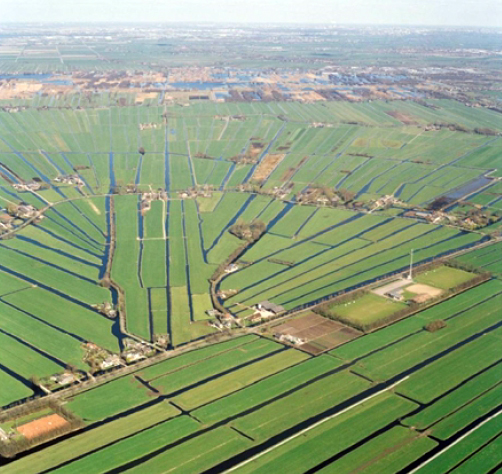Peat meadow areas have to deal with soil subsidence and high emissions of carbon dioxide, because of the oxidation of the organic peat soil. The area also has to deal with climate change which makes the water management even more difficult, and which speeds up the process of oxidation of the soil.

Developed by Veenweiden Innovatiecentrum
We reduce the soil subsidence and the production of carbon dioxide by applying innovative sub-irrigation systems to the whole polder. It involves innovative ways of water management and land use in combination with sub-irrigation, to decrease the effect of climate change and water demand for sub-irrigation, to reduce emission of carbon dioxide (for about 50%) and soil subsidence, and also to improve water quality and biodiversity.

See more information about this level and the TRL and SRL levels.
The system’s main components have been individually tested, and an initial integration has been completed.
With sub-irrigation systems (drainage pipes under the water level of the ditches) water is infiltrated in the soil of the peat meadows and helps to prevent low ground water levels in dry periods. This reduces the oxidation of the organic peat soil. By no longer applying a fixed ditch water level, this effect can be increased and it makes it possible to store more water in the area in periods of heavy rainfall. Redesign of the profile of the ditches increases biodiversity and the possibility to store water. Additional measurements are considered.
Limitations/conditions under which this innovation does not work or is less effective
The degree of effectiveness depends on the local situation in the area where the innovations are applied. Do most farmers cooperate, the kind of peat, etc. That is not a problem in the polder tested so far, the Lange Weide area in the Netherlands, but it can be when applied in other areas. But there will always be a positive effect.
Added value
Reduction of soil subsidence and emission of carbon dioxide, and a more ‘climate proof’ water management.

Peat meadow areas have to deal with soil subsidence and high emissions of carbon dioxide, because of the oxidation of the organic peat soil. The area also has to deal with climate change which makes the water management even more difficult, and which speeds up the process of oxidation of the soil.

Developed by Veenweiden Innovatiecentrum
We reduce the soil subsidence and the production of carbon dioxide by applying innovative sub-irrigation systems to the whole polder. It involves innovative ways of water management and land use in combination with sub-irrigation, to decrease the effect of climate change and water demand for sub-irrigation, to reduce emission of carbon dioxide (for about 50%) and soil subsidence, and also to improve water quality and biodiversity.
The main components of the system have been tested separately, and an initial integration exercise has been conducted.
With sub-irrigation systems (drainage pipes under the water level of the ditches) water is infiltrated in the soil of the peat meadows and helps to prevent low ground water levels in dry periods. This reduces the oxidation of the organic peat soil. By no longer applying a fixed ditch water level, this effect can be increased and it makes it possible to store more water in the area in periods of heavy rainfall. Redesign of the profile of the ditches increases biodiversity and the possibility to store water. Additional measurements are considered.
Limitations/conditions under which this innovation does not work or is less effective
The degree of effectiveness depends on the local situation in the area where the innovations are applied. Do most farmers cooperate, the kind of peat, etc. That is not a problem in the polder tested so far, the Lange Weide area in the Netherlands, but it can be when applied in other areas. But there will always be a positive effect.
Added value
Reduction of soil subsidence and emission of carbon dioxide, and a more ‘climate proof’ water management.
Not a member yet?
No worries, you can register here.
Name field No Space Allowed.
Already a member? login here
Not a member yet?
No worries, you can register here.
You know what they say, sharing is caring! You can share this innovation with as many people you feel will be interested in it.
Tip: include a message about why it caught your eye.
Did something peak your interest? You can share any questions, praises, comments, or concerns and the company will recieve them directly. No need for middle-men here.
Lorem ipsum dolor sit amet, consectetur adipiscing elit. Ut elit tellus, luctus nec ullamcorper mattis, pulvinar dapibus leo.